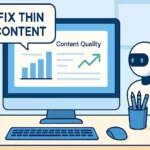The Psychology of Viral Content: How to Make Your Blog Posts Shareable

Introduction: The Elusive Viral Factor
Have you ever wondered why some blog posts go viral while others go completely unnoticed? The answer often lies in understanding viral content psychology—the science of why people feel compelled to share certain types of content.
Research based on a Wharton study analyzing nearly 7,000 New York Times articles found that content evoking high-arousal emotions—such as awe, anger, or anxiety—is significantly more likely to be shared. As detailed in the Journal of Marketing Research, emotional intensity—not just positivity or negativity—drives virality.
If you’re just getting started, be sure to check out our guide How to Start a Blog and Make Money in 2025 to lay a strong foundation before diving into advanced strategies like virality.
In this comprehensive guide, I’ll break down the science-backed principles that trigger sharing behavior and provide you with actionable strategies to make your blog posts inherently more shareable—expanding your reach exponentially without increasing your marketing budget.
Psychological Triggers in Viral Content Psychology
1. The Emotional Activation Effect
Studies in viral content psychology have shown that emotionally charged content is more likely to be shared—especially when it evokes awe, anger, or anxiety. This principle is clearly reflected in our guide How to Increase Email Open Rates by 37%, where emotionally compelling subject lines drive significantly higher engagement.
But not all emotions are created equal when it comes to sharing:
| Emotion | Sharing Potential | Examples of Content Types |
|---|---|---|
| Awe | Very High | Breakthrough discoveries, stunning visuals, unexpected solutions |
| Anger | High | Injustice exposure, controversial opinions, policy critiques |
| Anxiety | Medium-High | Warning posts, preparedness content, risk awareness |
| Joy | Medium-High | Success stories, positive news, uplifting achievements |
| Sadness | Low | Personal tragedy, depressing news, problems without solutions |
Key Insight: Content that activates high-arousal emotions (awe, anger, anxiety, excitement) is shared more frequently than content that triggers low-arousal emotions (sadness, contentment).
2. Social Currency & Identity Signaling
People share content that makes them look good to others—it’s human nature. Psychologist Jonah Berger, author of “Contagious: Why Things Catch On,” calls this “social currency.”
When your readers share your content, they’re essentially saying:
- “I’m knowledgeable about this topic”
- “I have access to valuable information”
- “I care about these important issues”
- “I’m connected to exciting trends”
Actionable Strategy: Create content that helps readers enhance their perceived identity and social standing. For example, ConvertKit vs Mailchimp for Bloggers compares how each platform supports identity-driven communication and personalization—key aspects of social currency. This could include:
- Early access to emerging trends
- Counter-intuitive insights that challenge conventional wisdom
- Data-backed findings that others in their network will find valuable
- Exclusive information that positions them as “in the know”
3. The Practical Value Principle
The Practical Value Principle
Content that provides immediate, tangible value triggers what psychologists call a “reciprocity impulse.” When you genuinely help someone solve a problem, they often feel compelled to reciprocate—typically through sharing.
A BuzzSumo study analyzing 100 million headlines found that practical utility is one of the strongest drivers of social shares. The most shared content types include:
- Step-by-step guides
- Curated resource collections
- Actionable frameworks
- Decision-making tools
You can see this principle in action in The Ultimate Guide to Monetizing Your Email List in 2025, where actionable strategies directly lead to monetization results.
This is why “how-to” posts and actionable listicles consistently outperform abstract or purely theoretical content when it comes to shareability metrics.
4. The Social Proof Cascade
Humans are inherently social creatures, and we look to others’ behavior to determine what’s valuable or worth our attention. When content appears to be widely shared already, this creates a psychological validation loop that encourages even more sharing.
This tipping point effect is a classic example from viral content psychology, showing how social proof accelerates engagement.
Format Strategies Backed by Viral Content Psychology
1. Conversation-Style Writing That Resonates
Neuroscience research confirms a key principle of viral content psychology: when readers engage with conversational text, they activate the same brain regions used in real-life conversations—making the experience feel more personal and share-worthy.
To write in a conversational style:
- Use contractions (don’t vs. do not)
- Ask questions throughout your content
- Employ the second-person “you” perspective
- Share personal anecdotes or examples
- Vary your sentence structure (including some shorter sentences)
Avoid: Overly formal language, complex sentence structures, and excessive jargon—all of which create psychological distance between you and your reader.
2. Headline Psychology: The 4U Formula
Your headline is the single most important factor determining whether your content gets clicked—and potentially shared. The most compelling headlines follow the copywriting classic—the “4U Formula”:
- Useful: Promises a valuable benefit
- Urgent: Creates a sense of timeliness
- Unique: Offers something novel or unexpected
- Ultra-specific: Provides concrete details, not vague promises
Headline Analysis Tool Comparison:
| Tool | Best For | Key Features | Cost |
|---|---|---|---|
| CoSchedule Headline Analyzer | Overall headline quality | Emotional value, power word analysis | Free basic version |
| ShareThrough | Engagement prediction | Emotional engagement scoring | Free |
| Advanced Marketing Institute | Emotional impact | Emotional Marketing Value (EMV) score | Free |
| Headline Studio | SEO optimization | SEO score + readability metrics | Paid ($19/month) |
3. The Visual Processing Advantage
Our brains process visual information 60,000 times faster than text, which explains why content with compelling visuals earns 94% more views than content without.
Visual elements that boost shareability:
- Custom-designed featured images
- Data visualizations and infographics
- Comparison charts and matrices
- Process diagrams and flowcharts
- Screen captures with annotations
Pro Tip: Even a single custom visual that summarizes your key point can dramatically increase sharing rates, particularly on visual-first platforms like Pinterest and Instagram.
4. The Skimmability Factor
Eye-tracking studies have consistently shown that online readers scan rather than read exhaustively. Content formatted for skimmability receives significantly higher engagement and sharing rates.
Optimize for skimming by:
- Using descriptive subheadings (H2, H3, H4)
- Including bulleted and numbered lists
- Bolding key information
- Keeping paragraphs under 3-4 sentences
- Adding summary boxes for complex sections
Case Studies That Prove Viral Content Psychology Works
Case Study #1: “Why Generation Z Hates Phone Calls” (Wait But Why)
This post by Tim Urban generated over 500,000 shares by combining:
- Emotional resonance: Tapped into anxiety about modern communication
- Identity signaling: Helped readers understand their own behavioral patterns
- Memorable visuals: Featured simple but humorous stick-figure illustrations
- Conversational style: Used casual language and self-deprecating humor
The post succeeded because it validated readers’ own experiences while providing a framework to understand a common social phenomenon.
Case Study #2: “1,000 True Fans” (Kevin Kelly)
This influential essay has been shared millions of times because it:
- Created a new mental model: Introduced the concept that creators need only 1,000 true fans to succeed
- Provided practical hope: Offered a concrete, achievable alternative to traditional success metrics
- Used impeccable logic: Built its case through clear reasoning and examples
- Featured a memorable core concept: The “1,000 true fans” idea is inherently sticky and easy to reference
The post became viral because it provided both emotional relief and practical strategy to creators feeling overwhelmed by the digital landscape.
Case Study #3: “The Ultimate Guide to Meta Descriptions” (Moz)
This SEO-focused post earned exceptional sharing because it:
- Delivered comprehensive value: Covered every aspect of the topic exhaustively
- Used concrete examples: Included before/after examples for multiple industries
- Featured visual instructions: Provided screenshots for implementation
- Structured information hierarchically: Used clear sections that made the content easy to navigate
The post’s virality stemmed from its perfect blend of authoritative knowledge and immediate actionability.
Actionable Strategies Based on Viral Content Psychology
1. Implement the STEPPS Framework
Jonah Berger’s research identified six key principles (STEPPS) that drive content sharing:
- Social Currency: Make readers feel like insiders
- Triggers: Connect your content to common environmental cues
- Emotion: Activate high-arousal emotional responses
- Public Visibility: Create content that’s naturally demonstrable
- Practical Value: Provide immediately useful information
- Stories: Wrap your information in narrative structures
- One example of narrative-based strategy is in Digital Product Creation: From Concept to Cash in 30 Days, which follows a chronological transformation arc.
Implementation Checklist:
- Does your content make readers feel knowledgeable if they share it?
- Have you connected your topic to daily experiences or current events?
- Does your content evoke at least one high-arousal emotion?
- Is your content formatted for easy public consumption?
- Have you provided actionable takeaways?
- Did you incorporate narrative elements that make your points memorable?
2. Design Share-Worthy Visual Elements
Create at least one highly shareable visual for every significant blog post:

Visual Content Checklist:
- Contains your key insight in visual form
- Includes your brand identity elements (colors, logo)
- Works well at multiple sizes (mobile to desktop)
- Can stand alone as valuable content
- Uses easy-to-read typography
- Incorporates data when relevant
3. Optimize for Platform-Specific Sharing
Different platforms favor different content characteristics:
| Platform | Optimal Content Type | Ideal Headline Style |
|---|---|---|
| Data-driven, industry insights | Professional, insight-focused | |
| Emotional, identity-affirming | Question-based, controversial | |
| News, surprising facts, humor | Brief, intriguing, number-based | |
| Visual guides, aspirational content | “How to” and list-based titles | |
| In-depth analysis, unique perspectives | Direct, descriptive, no clickbait |
Platform Optimization Tip: Create platform-specific snippets for each major social network when promoting your content, rather than using the same text everywhere.
4. The “Shareability Audit” Checklist
Before publishing any content, run it through this shareability audit:
- Identity Enhancement: Does sharing this make the reader look good?
- Emotional Activation: Does it trigger at least one high-arousal emotion?
- Social Proof Elements: Have you included statistics, testimonials, or examples?
- Practical Application: Can readers immediately apply what they’ve learned?
- Visual Highlight: Is there at least one standout visual element?
- Mobile Optimization: Does the content format well on mobile devices?
- Share-Worthy Snippets: Have you included “tweetable” quotes or insights?
- Call-to-Action: Have you explicitly invited sharing (without begging)?
Expert Opinions on Viral Content Psychology in Action
Larry Kim (Founder of MobileMonkey):
“The content that achieves massive sharing velocity typically combines a strong emotional hook with unexpected information. When readers experience the ‘I didn’t know that!’ moment, they’re compelled to share that feeling with others.”
Ann Handley (Chief Content Officer at MarketingProfs):
“The most shareable content doesn’t just inform—it transforms how people think about a topic. When your content shifts someone’s perspective, sharing becomes a natural extension of that transformative experience.”
Rand Fishkin (SparkToro Founder):
“Extraordinary content—content worth sharing—takes a unique angle on a familiar problem. It’s not just about being comprehensive; it’s about approaching a topic from a perspective no one else has explored.”
Sonia Simone (Copyblogger):
“The psychology of sharing is ultimately about human connection. People share content that helps them connect more meaningfully with their network. That’s why content that facilitates conversation, rather than just consumption, spreads fastest.”
To truly understand how shareable your content is, look beyond simple share counts to these more meaningful metrics:
- Share-to-View Ratio: What percentage of people who view your content actually share it?
- Share Velocity: How quickly does sharing accelerate in the first 24-48 hours?
- Cross-Platform Spread: Does your content get shared across multiple platforms or just one?
- Secondary Sharing: Do people who see your content shared by others then share it themselves?
- Engagement-to-Share Ratio: How many comments/interactions occur per share?
Measurement Tool Comparison:
| Tool | Best For | Key Metric | Price Range |
|---|---|---|---|
| BuzzSumo | Content research | Industry benchmarks | $99–$499/month |
| Sprout Social | Platform-specific analysis | Share demographics | $89–$249/month |
| Hootsuite | Share tracking | Share velocity | $49–$739/month |
| Google Analytics | Source attribution | Referral quality | Free–$150,000/month |
Creating viral content isn’t about luck or magical thinking—it’s about applying the core principles of viral content psychology that drive human sharing behavior. By intentionally crafting content that:
- Triggers high-arousal emotions
- Provides social currency
- Delivers immediate practical value
- Incorporates powerful visual elements
- Follows proven structural formats
You dramatically increase the probability that your content will be shared widely, expanding your reach organically.
To see these principles in action, read How I Created a 5-Figure Passive Income Blog Using Bluehost, where structure and emotion played key roles in traction.
Remember that true virality isn’t just about getting attention—it’s about using viral content psychology to create content so valuable that your readers become your most effective distribution channel.
Ready to take your content strategy to the next level? Join my Telegram channel “BloggingRevenue” for daily tips on creating content that doesn’t just get read—it gets shared.
Q1: How long should content be to maximize shareability?
A: BuzzSumo’s analysis shows that long-form content (1,500-3,000 words) receives more shares on average than short-form content. However, the correlation isn’t with length itself but with depth and comprehensiveness. Focus on creating exhaustive resources rather than hitting a specific word count.
Q2: Does controversy actually increase shareability?
A: Yes, but with important caveats. Content that challenges established beliefs in a thoughtful, evidence-based way tends to perform well. However, content that’s controversial purely for shock value often generates negative engagement without beneficial sharing. The key is “productive controversy” that adds value to the conversation.
Q3: How important is timing for content virality?
A: Timing can significantly impact initial traction. Publishing when your target audience is most active gives your content the best chance of reaching critical mass quickly. For most B2B content, Tuesday and Thursday mornings (9-11 AM) show the highest sharing rates, while consumer content often performs better in evenings (7-9 PM) and on weekends.
Q4: Can you make previously published content more shareable?
A: Absolutely. You can increase the shareability of existing content by:
- Updating it with new information or examples
- Adding new visual elements
- Restructuring for better skimmability
- Creating platform-specific promotional assets
- Adding “click to tweet” functionality for key insights
- Refreshing the headline for stronger emotional impact
Q5: Do different industries have different sharing triggers?
A: Yes. While the fundamental psychology applies across sectors, the emotional drivers vary significantly:
- Tech content: Awe and surprise drive sharing
- Health content: Anxiety and hope are primary motivators
- Financial content: Fear and relief generate most shares
- Lifestyle content: Aspiration and identity connection lead sharing
Understanding your specific industry’s emotional triggers is essential for optimizing shareability.







